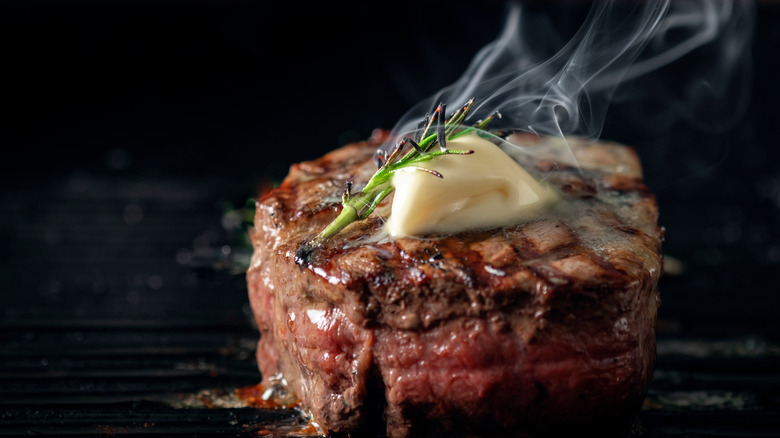The Rookie Mistake Chefs Make With Gordon Ramsay's Filet Mignon - Exclusive
Beef Wellingtons are the poster dishes at Gordon Ramsay's Hell's Kitchen restaurants, but the chef also boasts a signature steakhouse, Gordon Ramsay Steak, to prove his mastery in New York strips, rib-eyes, and filet mignons.
Don't go up against him in steak-themed trivia, Ramsay would win. He's even filmed a guide to help us catch up to him. Watch and learn: Rump is good for stir-fries; Marinate hanger and cook it quickly; Filet is incredibly tender and great for an "ultimate steak sandwich." This is the cut of meat that Ramsay calls "the Rolls Royce of beef." You can watch him prep a filet and take note as the star chef seasons it — rolling in salt and large grains of pepper — and then carefully places it (don't drop it!) into his pan coated in olive oil. But even if you follow Ramsay's instructions as laid out in the video to the letter, you may have already broken a cardinal steak-making rule.
As Ramsay told Tasting Table, the number one novice mess-up that his chefs make when prepping a filet mignon has little to do with the seasoning or cooking process at all.
Don't forget to do this before you cook a steak
The culinary master of "Hell's Kitchen" is well known for his zero-tolerance policy for overcooked or undercooked meat. Mastering the perfect steak cooking time and method is useless, however, if you've skipped an important pre-cooking step. What's the most common error chefs-in-training make when learning the art of Gordon Ramsay's filet mignon? Tasting Table asked the culinary wizard in an exclusive interview. "The rookie mistake that everyone makes is they cook the steaks ice-cold," Ramsay told us. "They take them straight out of the refrigerator and they put them into the pan." Never do that — not if you want to live up to Ramsay's Michelin-starred expectations.
Per Ramsay, the pre-cooking process is just as important as what you do after your steak hits the pan. "A steak needs to rest. It needs to rest before you cook, it needs to tenderize, it needs to be seasoned, and it needs to be rubbed either in a beautiful dry rub or lightly drizzled with a touch of olive oil," Ramsay detailed. "Get the steak up to room temperature."
There's a secondary mistake people tend to make that leaves to sub-optimal steak results according to Ramsay — adding butter too soon. "Start off with a beautiful oil — peanut oil or rapeseed oil — then put the butter in at the end to baste it," Ramsay detailed. "But the importance of cooking a great steak is letting it rest. That is absolutely crucial."

